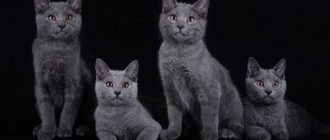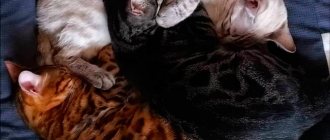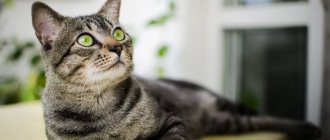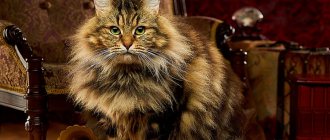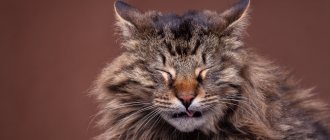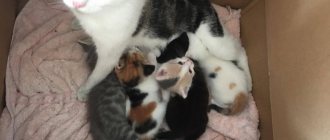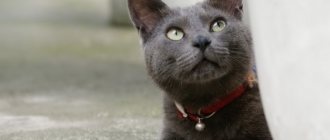| Country of origin | Thailand, UK |
| Dimensions and weight | 4-6.5 kg, length - 60 cm |
| Wool | short, there is a semi-long variety |
| Lifespan | 13-16 years old |
Graceful, slender, sophisticated, incredibly flexible - that's all she is - an oriental cat. But the apparent fragility of these animals is combined with excellently developed muscles and a love of movement. Orientals belong to the Siamese-Oriental group of cats. Therefore, representatives of the breed are often called “Asians”, “Orientals”, “Oriental”, “Orik”, “Ori”. There are other names, some of them are already outdated: cat greyhound, shorthaired pointer, oriental shorthair.
History of the breed
The Oriental Shorthair is a cousin of the Siamese cat. More precisely, it is one breed, but with different colors and eye colors. Siamese have a light body, blue eyes, Orientals have a fully colored body and green eyes. There are no more differences, not even in character.
In ancient Thailand, the Oriental cat was one of the varieties of Royal Siamese cats, which were revered in the imperial palace and temples.
Part I
The ancestors of the Siamese and Orientals were brought from Thailand to England at the same time (late 19th century). There is information that at an exhibition in London in 1896, an oriental cat of a solid blue color was presented. But she was disqualified because there was no Siamese color. The popularity of the Siamese with its point coat and blue eyes has eclipsed the Orientals. And in 1923, the British Siamese Cat Club finally excluded solid green-eyed cats from the Siamese class. All activities related to breeding the breed were stopped.
Part II
After World War II, as the Siamese population declined, some breeders returned to breeding colored cats. First, work began on breeding chocolate-colored oriental cats, which were given the name Havana. A number of historians claim that the shade of the wool is comparable to the rich color of a Havana cigar, hence the name. Then they started breeding lilac orientals, with different colors and patterns.
Part III
An equally interesting story began in America. In 1956, the chocolate cat ended up in California (USA), where they almost immediately began to recognize it as a new breed. In 1964, the CFA approved the independent Havana Brown breed, giving it champion status. Therefore, in Europe, Havana Brown is a chestnut color, and in America it is a separate breed. The same story happened with white Asians, who in 1974 received breed status under the name “Foreign White”.
To obtain new colors, breeders infused Asian cats with the blood of American Shorthair, Abyssinians, Burmese, and Russian Blues.
After this, a campaign began to recognize solid Siamese cats as a separate breed. Already in 1977 the standard was approved. This year and the next, the Oriental breed was at the peak of its fame, entering the top ten most popular. The only exception was for cats with bicolor colors. But in 1995, justice triumphed - the color was recognized.
History of the Oriental cat breed
Oriental cat
Genetically, oriental cats are close to the Siamese, with whom they began to be exported from Thailand in the 19th century. British breeders did not consider (or did not want to consider) green-eyed cats as an independent breed, so they classified them as a classic Siamese with a modified type of color. It is worth noting that at European exhibitions Orientals were not particularly favored, systematically disqualifying mustachioed emigrants either for non-standard colors or for the emerald shade of the iris.
The animals also did not arouse much interest among potential owners, so until the beginning of the 20th century, Oriental cats were bred only by enthusiasts who were passionate about breeding activities. The real crisis fell on the Thai Eared Cat in 1923, after the American Siamese Cat Club strictly tabooed the breeding of any variety of pets, with the exception of blue-eyed individuals with the Himalayan color.
For almost 30-odd years, Orientals were in limbo: they were expelled from the Siamese clan, but were never recognized as an independent breed. They remembered the cat only in the 60s by British and American breeders, who were carried away by the extreme appearance of animals. Initially, breeders planned to develop another variety of Siamese cat, which would have a uniform coat color, but would not lose the grace of its lines. To achieve this goal, Orientals began to be crossed with Abyssinians and other short-haired breeds.
1977 was a landmark year for Orientals, in which the wards of American breeders received their own standard of appearance. By the way, the first set of breed characteristics developed for overseas murkis was almost completely copied from the Siamese standard (with the exception of the points “body” and “colors”). But in Britain they were in no hurry to honor Asian cat breeds and spent 20 long years looking closely at them, scrupulously weighing the pros and cons. As a result, English long-eared cats were able to become an independent breed only in 1997, after official recognition by the GCCF.
Oriental cat with cat
Black oriental cat
Oriental semi-longhair cats
In the 80s In the 20th century, oriental cats with long hair, called British Angora, were registered in England. The breed was recognized by the largest felinological system - GCCF. In 2003, the name was changed - the British Angora became the Oriental Longhair.
In America, a cat with silky long hair, a feathered tail and a small beard was the result of crossing a shorthaired Oriental and a Balinese. The kittens received a Balinese build and semi-long hair, but the color remained oriental. In 1997, Oriental Longhair was recognized in the USA.
The Oriental Longhair breed has other names - Oriental Longhair, Mandarin.
Appearance of an oriental cat
Orientals are typical Asians: graceful, lean, with the hypnotic power of a jade gaze. A distinctive feature of these charismatic pussies is their phenomenal plasticity of movements, thanks to which even ordinary stretching in their performance turns into a full-fledged yoga master class. Based on their coat type, Oriental cats are divided into short-haired and long-haired. The latter variety was born in the 60s of the last century as a result of crossing a shorthaired Oriental with a Balinese (Balinese cat). The Oriental Longhair was introduced as an independent breed in 1977, but it was only able to confirm its worth at exhibition competitions in 1997.
Head
Oriental kitten
According to the standard approved by the WCF (World Cat Federation), the head of an Oriental must have a flat forehead and a prominent profile. The muzzle of representatives of this breed should be narrow, and the chin line should be clearly defined. A mandatory item is the wedge-shaped shape of the skull.
Nose
Elongated, smooth. Located approximately in line with the chin.
Eyes
Almond-shaped, slightly slanting. The distance between the eyes is visually equal to the length of one of them. Regardless of coat color, all Orientals have rich emerald eyes. An exception to the general rule are white-haired individuals, whose iris color may be blue. Some cats have heterochromia (different eyes).
Ears
Quite massive in relation to the head. The ear flap is thin and wide, continuing the wedge-shaped line of the cat's muzzle. The tip is slightly rounded. The most intensive growth of the ears is observed in the first months of the animal’s life, which is why the Oriental kitten resembles a hybrid of Cheburashka and Yoda from Star Wars.
Neck
Graceful, elongated type.
Oriental cat face
Torso
Slender, noticeably elongated in length, with a well-developed muscle corset. The constitution of the body is close to lean: the animals look elegant and graceful.
Limbs
Oriental longhair cat
Oriental cats have extremely long limbs, giving their silhouette a slight aristocracy and grace. The animals' paws are oval and relatively small.
Tail
Whip-shaped, very long, with a sharp tip. The thickness of the tail is the same along its entire length.
Wool
Oriental cats have virtually no undercoat, allowing the fur to softly outline the contours of the body. The hair of short-haired individuals is shiny, satin-type. Long-haired animals have thin, silky hair. Since representatives of the second type have hair that fits tightly to the body, its real length is partially “lost.”
Color
Curled up into a ball
What the breeding experts were most loyal to were the color options for Orientals. Today, this is one of the few cat breeds that has the right to almost any shade of all existing ones.
In order to systematize the “colors” of eared cats, their basic types were identified by felinological associations. In particular, modern Oriental cats can have coats of such colors as:
- lilac (lavender);
- blue;
- red;
- Havana (brown);
- cinnamon (cinnamon);
- faun (beige);
- ebony (black);
- cream;
- white.
The preferred tabby colors are merle, brindle, ticked and spotted.
Defects and disqualifying defects of the breed
Serious defects that spoil the aristocratic appearance of Oriental cats include strabismus, any shade of the iris except green, as well as protruding and clearly palpable cartilage in the sternum area. As for exhibition events, first of all polydacts, very small or too thin individuals and cats with kinked tails will not be allowed to attend. The list of defective pets includes animals with insufficiently strong hind legs, spots on the fur in the form of medallions, as well as cats that breathe through their mouth. In the long-haired variety of Orientals, a double coat with a well-developed undercoat may be a reason for disqualification.
Description of the breed
The appearance of the oriental cat provided another interesting name - “greyhound of the cat world.” A beautiful, graceful body, long legs, a whipping tail, an elongated muzzle with expressive eyes and large ears make the image of the Oriental recognizable.
The standard is very similar to the Siamese breed standard. Only in the description of the head and body the word “medium” was replaced with “long”. And also, unlike the Siamese and Thai cats, the fur of Orientals does not change tone due to climatic conditions and hormonal changes.
The Oriental breed is a medium-sized cat. As with other breeds, males are much larger than females. So, the average weight of a male is 4.5-6 kg, a female weighs 3-3.7 kg. Body length without tail is on average 60 cm, height – up to 35 cm.
The standards of the leading felinological systems differ little from each other when assessing the Oriental breed.
Breed standard:
| Become | Description |
| Head | The skull is a well-defined wedge. The nose is straight and long. There is no transition from nose to forehead. The chin is strong, strong, but not massive. The neck is long and slender. |
| Ears | Wide at the base, tapering towards the tip. Set low and wide. The size is very large. The tips of the ears should not droop. |
| Eyes | They are shaped like almonds. The color is rich green without inclusions. An exception is for white orientals, in which blue or different colors are acceptable. |
| Body | Elongated, toned, with well-developed muscles. Shoulders are no wider than hips. |
| Legs | Slender, long, with developed muscles. The hind legs are longer than the front ones. Thanks to this, Orientals are distinguished by their jumping ability. Small, oval paws. |
| Tail | Thin, sharp at the tip, without creases or knots. The length is in harmony with the body, reaching the shoulder blades or a little further. |
| Wool | Very short, silky (with a satin effect), close to the body. There is no undercoat. The Oriental Longhair cat has flowing, fine fur. Because the hairs fit tightly to the body, the fur appears shorter than it actually is. |
Oriental cat health
Possible diseases
Oriental cats cannot be called the owners of good health. Despite the fact that on average they live 15-17 years, they are characterized by a number of diseases inherited from their Siamese ancestors.
The most common genetic disease among representatives of the breed is liver amyloidosis, which leads to liver failure, and in its neglected form, to the death of the pet. The symptoms of the disease are quite specific, but if activity weakens and appetite deteriorates, you should immediately contact a veterinary clinic for advice.
Problems with the functioning of the heart are caused by a disorder in the myocardium, this is the so-called dilated cardiomyopathy. Diagnostics using an ultrasound machine, which is done every six months of the oric’s life, will help prevent it.
Unusual, slightly slanted eyes can also cause unpleasant moments. In addition to inflammation and conjunctivitis, hereditary strabismus and retinal atrophy are possible.
Flat chest syndrome in newborn kittens leads to underdeveloped lungs and death from suffocation if the baby is not noticed and treated in time.
The large ears of an Asian cat are prone to otitis media and inflammation. If the problem is not dealt with in time, you can end up with an animal with hearing loss or complete hearing loss.
An incorrectly selected diet can lead to obesity or the development of food allergies in pets. Because of this, the state of health is impaired, and the appearance of the coat deteriorates, which becomes dull and begins to shed more.
Reproductive health
A cat becomes sexually mature by 1-1.5 years of age. At the same time, mating of seals and female cats of this breed is allowed. It is not worth doing this earlier, because the female’s body will not be completely ready to bear and give birth to healthy offspring. Cats that are too young produce non-viable or unhealthy litters.
Pregnancy and childbirth among Oriental women do not have any peculiarities unique to them. Like all felines, they may need human assistance during lambing. There can be 3-7 kittens in a litter.
Females and males become caring, responsible parents.
Females can be sterilized after a year of life, and boys can be castrated at the age of 6-7 months. The health of a cat directly depends not only on care, but also on timely sterilization - unless, of course, breeding is planned.
Rainbow colors
Representatives of the Oriental breed have more than 300 color varieties. For such abundance, the Oriental Shorthair received the nickname “rainbow cat.”
With all the variety of colors, patterns and types, the color of the eyes is exclusively green.
Solid colors
- Ebony (ebony). One of the most beautiful, making the cat look like a black panther. The fur is completely jet black from tip to root, without a hint of rusty hairs. The same black paw pads and tip of the nose.
- Chestnut (chocolate, Havana). Uniform, warm chestnut brown color. An animal with a Havana coloration looks very exotic.
- Lavender (lilac). The fur is pink-gray, as if covered with frost. But the color should not be too blue or fawn. The nose and paw pads are pinkish-lilac.
- Blue. The coat is uniformly blue, without a hint of silver or rust. The paw pads and nose are the same.
- Red. Monochromatic, no patterns or shades.
- Cream. Pure color preferably light tones.
- Tortoiseshell. There are spots scattered all over the cat's body. This happens if the main coat color is diluted by a red or cream color.
- Faun. Light beige color, which is called the “color of a young fawn.”
- Cinnamon (cinnamon color). All chocolate brown tones: brown, sandy brown (not red) with copper or bronze undertones. Markings may be visible on light coats - this is acceptable, but preference is given to a richer, purer color.
- Smoky. A variation when, with the main or tortoiseshell color, the lower part of the hairs remains white due to the lack of pigment.
- White. Pure white color without a hint of yellowness. The eyes of such cats can be blue, green, or one blue, the other green.
Tabby colors
Patterned colors such as brindle, harlequin, ticked, and spotted are common. All varieties are characterized by the letter M on the forehead, lines from the outer corners of the eyes to the back of the head, several necklaces on the neck, 2 rows of dots running along the chest and stomach. Rings cover the legs and tail.
Varieties of patterned colors:
- Brindle. A narrow continuous line runs from the back of the head to the tail. The entire body is covered with stripes running from the spine to the lower abdomen.
- Spotted. It is similar to a brindle, but the longitudinal and transverse stripes are divided into spots of different shapes - round, oval.
- Marble. Lines run from the head to the shoulders, forming a butterfly-shaped pattern. Three parallel lines can be traced along the back from the “butterfly” to the base of the tail. On each side there are spots symmetrically located, surrounded by one or more rings.
- Ticked. There is no pattern on the body, but each hair consists of alternating areas of dark and light color.
Buy an oriental cat
A purebred oriental kitten can be bought at a nursery, but it is better to ignore sites like Avito. Why? In nurseries you can be guaranteed to get a healthy animal, examined and purebred, but in someone else’s hands a pet may simply be unhealthy. If the pedigree contains the name Casimir, the ancestor of many representatives of the oriental cat breed, then it is better to quickly purchase a baby before someone smarter takes it. The origin of the future family pet must be impeccable in all respects.
The cost of a kitten is high: 20,000 – 40,000 rubles, but you don’t mind the money for such a cat.
Character of an oriental cat
All oriental cats have a unique character. Orientals are no exception. Developed intelligence, intelligence, quick wit, affection for the owner, playfulness, talkativeness and eternal busyness - these are the main characteristics of the breed. And the behavior is called nothing less than “dog-like.”
Orientals are one of the most talkative cats. These are very emotional animals. They are not shy about purring, purring loudly just to express their feelings. But not idle. If a cat purrs, it means he needs to speak out: perhaps something hurts, or he is scared or, conversely, happy. Any action does not take place silently, but is accompanied by “conversation.” He will not shake the air while no one is home. He needs a person to communicate.
It is not known what Orientals love more - chatting or being close to the owner. Ori are loving, and become so attached to their owner that they can become depressed if he is absent for a long time. This breed is recommended for people who spend most of their time at home. Either take 2 cats into the house at once or get some other pet. Orientals are friends with everyone. They get along well with children and enjoy playing with them. Get along well with other animals. The adjustment period takes very little time. They find a common language quite quickly even with a dog. Only first they will try to take the position of leader. If the dog does not agree, conflict cannot be avoided. Here the owner’s task is to help make friends between the cat and the dog.
Oriental cat nutrition
Although cats of this breed have a slender figure, they are prone to obesity and overeating. Therefore, the owner of an oriental beauty must carefully take care of the good shape of the pet, purchase premium food, and feed his cat in small portions.
The food should be natural; it is best to use ready-made dry food and premium canned food. To maintain a beautiful and shiny coat, cats of this breed need fats. You can ensure a sufficient amount of them by adding a small piece (no more than a gram) of butter to each meal.
Orientals tolerate milk and dairy products well, but they should not be given often (only a couple of hours after the last meal).
All food for cats of this breed should be at room temperature, and the environment during feeding should be calm and quiet. The nervous system of Orientals should always be in a calm state.
Under no circumstances should you feed a cat of this breed river fish. Otherwise, your pet may choke on the bones. Fatty fish should also be excluded from the diet.
Feeding your cat hourly is not advisable; it will likely lead to overeating and fat accumulation. It is better to simply leave some dry food in the bowl, and there should always be plenty of fresh, clean water.
Pork should be completely excluded from the diet, vegetables and boiled meat should be added. You can only fish from the ocean and boiled; it is best to choose oat or wheat porridge.
Care and maintenance
Oriental cats do not require any special care. However, it is up to the owner to ensure that the pet lives longer, is healthy and happy.
The Oriental needs daily exercise and play that stimulates its natural instincts to hunt and explore. Therefore, it is better to keep your cat's body and mind active, otherwise behavior problems may develop.
In addition, due to their activity, Orientals are the cats that fall out of windows more often than others. Therefore, when keeping an apartment above the 2nd floor, nets on the windows and a glazed balcony are required.
Grooming
The lack of undercoat and short hairs do not cause trouble to the owner. Of course, Orientals also shed. But it is enough to comb them periodically with a rubber brush or a special glove. There is practically no wool on clothes or furniture. Mostly it accumulates in the resting place.
Tangerines have a small undercoat, which gives them more wool. Brush the animal 1-2 times a week, every day during shedding.
Water treatments
Orientals are bathed only when they are heavily soiled, for example, by accident, or before an exhibition. Most cats do not like to bathe, and the Oriental is no exception. It is important after washing to prevent the animal from getting into a draft.
Nail care
Claw trimming is carried out every 2 weeks. But these terms are arbitrary; some pets will need to do this every 10 days, others – once a month. The procedure is carried out with a special tool (nail clipper) so as not to damage the claws.
Care for ears, eyes, teeth
An obligatory part of care is cleaning the ears, eyes and teeth. They are accustomed to the procedure from infancy, otherwise the cat will resist.
Wipe the ears and eyes with a cotton pad soaked in warm boiled water or a special lotion.
Cats don't take very good care of their teeth. Without additional help from the owner, there is a risk of dental disease. Typically, it all starts with plaque, which should be combated by regular brushing.
Deworming
Prevention of worms is a mandatory procedure. It is carried out 10 days before vaccinations and preferably every six months. There are a lot of deworming drugs. The dosage of almost all is selected by weight. Veterinarians recommend choosing complex medications that act on different types of worms.
Toilet issue
All kittens in the nursery are already litter box trained. And at first it is better to use the same type of tray that the breeder had. This way the kitten will adapt faster and learn to go to the right place.
Orientals love to dig. Therefore, it is better to choose a tray with high sides or a toilet-house. Any filler your pet likes.
How long do oriental cats live?
Oriental cats have a fairly typical lifespan for felines - an average of 5 years, but there are also centenarians. With proper care, nutrition, and the absence of genetic diseases, the Oriental, without losing its playfulness, can live up to 20 years.
Is the Oriental cat hypoallergenic?
The Oriental Shorthair has short hair, so it does not shed as much as other breeds. Researchers also believe that Orientals produce less protein, which is the main allergen. These 2 facts became the basis for including the Oriental cat in the list of hypoallergenic breeds. However, no breed is 100% allergen-free.
Raising an Oriental cat
It so happened that genetically Asians inherited a sharp mind and well-developed intellect. This explains their high ability to learn and train. For example, they can easily master a number of simple commands or retrieve a thrown object.
Despite this, cats love to mischief and are also capable of minor mischief. Rules of behavior and etiquette must be instilled in the kitten from the moment it appears in the house, otherwise curtains or flower pots will be in danger of being destroyed. It is difficult for cats to understand their guilt, so the owner must patiently point out his misdeeds and not leave pranks unattended.
Judging by the intonation of the person’s voice, the Oriental will quickly understand his mistake, and repeated expressions of dissatisfaction on the part of the owner should reduce the problem to nothing. They have well-developed intuition. But you should not hit or physically punish your pet; raising an Oriental cat in this way will not lead to anything good.
Your pet should learn to use the litter box at an early age and not confuse it with other containers or even shoes. Usually, there are no problems with how to toilet train an Orika. Representatives of the Asian breed are very clean individuals, so they strictly adhere to hygiene rules.
Feeding
Orientals value a fit and muscular body, so they should not be overfed. But representatives of the breed are big food lovers. They will constantly demand food. If the owner refuses for some reason, then theft has not yet been abolished. They will find it, steal it, eat it. Therefore, you cannot follow the lead. One or two “begged” treats and the oriental will already “twist the ropes” out of the owner, and begging for a tidbit will become a habit. However, excess weight in cats not only spoils their appearance, but also causes health problems.
Natural nutrition
Orientals are not picky when it comes to food, but the diet must be balanced. This is not easy to achieve with natural feeding. However, if the owner is a supporter of natural nutrition for his pet, then when preparing and calculating the dosage, the following must be taken into account:
- A cat consumes 5 to 10% of its own weight per day in food. Kittens and young pets eat more, but with age the appetite becomes moderate. Of course, everything is individual, the main thing is that the cat gets enough to eat.
- As a percentage, daily feeding is 3https://68koshek.ru/soderzhanie/pitanie/perevesti-koshku-na-drugoj-korm0% meat (chicken, veal, chicken stomachs, hearts, necks), 25% vegetables (zucchini, pumpkin, carrots), 20% porridge (rice, buckwheat), 25% fermented milk products (cottage cheese, kefir, fermented baked milk, yogurt, yogurt).
- All new products are introduced into the diet carefully to avoid problems with the gastrointestinal tract and the development of food allergies.
Longhaired Oriental cat
In the Oriental family, there are sometimes long-haired representatives, which later began to be crossed with each other. Some felinological organizations call them Javanese or Balenesian cats.
Note!
Norwegian Forest Cat - description of the breed, character, habits and maintenance of the Norwegian (110 photos and videos)- Cat litter - detailed review, prices, how to choose, where to buy
Ragdoll - 110 photos, breed description, price, character and owner reviews
Health
Shorthaired Orientals and Mandarins have excellent health and strong immunity. But there is still a predisposition to certain diseases:
- Gingivitis is an inflammation of the gums that, without timely treatment, develops into periodontal disease.
- Cardiomyopathy is a heart disease in which the walls of the ventricle harden. The volume of the heart chambers decreases, which leads to the development of heart failure.
- Retinal atrophy is a hereditary defect in which the visual cells of the retina are destroyed, which leads to partial or complete blindness. The disease occurs both at a young age (3-4 months) and at a later age (after 4-5 years).
- Flat chest syndrome is a hereditary pathology. The chest becomes flat or funnel-shaped. The problem is identified immediately after the kitten is born.
Health and diseases of Oriental cats
Handsome men
Despite the fact that the average life expectancy of Orientals is 15-17 years, they cannot be called real big guys. By inheritance from Siamese ancestors, cats have inherited a whole set of genetic ailments that significantly complicate their lives. Many individuals are diagnosed with liver amyloidosis, which, if not treated promptly, can cause liver failure. Another scourge of the breed is myocardial disease (dilated cardiomyopathy), so the animal must undergo ultrasound diagnostics at least once every six months.
Eye problems among Oriental cats are also quite common. Most often, “Thais” suffer from strabismus and progressive retinal atrophy. In addition, there is always a risk of kittens being born with flat chest syndrome. If the disease is not recognized and treated in time, the baby’s lungs will not be able to work at full capacity, and he will simply suffocate.
Pros and cons of the breed
According to reviews from owners, the Oriental breed has many advantages, but there are also disadvantages, if you can call them that.
Good companion
Gets along well with children and other animals
Loving, affectionate, gentle
Easy to learn and trainable
Very talkative, she will definitely insert her meow on every occasion
Can be annoying, as it follows the owner's heels
Unable to remain alone for long periods of time
Siamese oriental cats
There is an opinion that Oriental cats are no different from their Siamese counterparts, and the main difference is only in the color of the fur and minor structural features of the face.
Look - British Shorthair cat - description of contents, selection of nutrition, character traits and breed (105 photos)
Orientals were not allowed at cat shows, as they were considered not the best offshoot of the single Siamese breed.
How to choose a kitten
When choosing and purchasing a purebred Oriental kitten, it is important to know:
- The breeder will not give away the kitten until it is 3 months old. If they sell smaller kittens, this is a reason to think about it.
- Each purebred kitten must have a birth certificate (birth certificate) or pedigree if it is a show kitten. A pet without documents is not a real Oriental.
If you have doubts whether the litter has been registered, you can always check with the club in which the nursery is listed.
At the age of 2 months, the litter is assessed (actuation). Kittens are divided into 2 categories: those who participate in further breeding and those who do not. The cost of the kitten depends on this. On average, it starts from 20 thousand rubles.
There are too many factors that influence the price. The main one is the type of kitten. The extreme type is valued higher - eared, with a long muzzle, thin bones, and very short hair. All breeders strive to get just such kittens. The price for them starts from 40 thousand rubles. Of course, the cost is determined by color, quality (the presence of defects reduces the cost), and the purpose of purchase (for breeding or castration). Therefore, the price for a kitten as a pet can be 100 thousand rubles, and with the right of breeding 120 thousand and more.
Description of Oriental breed cats
External elegance and elegance of an Oriental cat
capable of decorating the most sophisticated home. Females weigh less than males: 5 kg and 6-8 kg, respectively.
The head is medium in size and resembles an equilateral triangle. The long nose continues the line of the forehead. A straight line visually connects the nose and the tip of the chin.
The ears look large in comparison with the head. The base is wide, the tips are slightly rounded. Geometry is also important in the structure of the ears and head: the line of the ears continues the line of the wedge of the head. In an Oriental breed kitten, the ears grow quickly, making the little cat look like Cheburashka. Gradually, harmony occurs in the relationship between body and ears.
Almond-shaped eyes open on the third day after birth without signs of strabismus. Basically, the eye color is green, only representatives of the white color have blue eyes.
The body is elongated and tightly built, the stomach is lean. Cartilage protrudes on the chest.
The hind legs are longer than the front, all limbs are slender and strong, and the paws are small and round in size.
It is impossible to imagine an Oriental cat without a thin and long tail.
Longhaired Oriental breed
The long-haired variety was bred in North America, presumably in 1985, by crossing a short-haired Oriental and a Siamese. Many associations and breeders immediately recognized such exotic beauties.
The weight of Oriental longhaired cats is 4-6 kg. Popular colors of longhairs: shaded, tabby, smoke, and the character is extremely friendly and curious. Externally, Oriental cats are similar to Balinese cats, with the exception of coloring.
Shorthair Oriental breed
The two types of graceful cats differ in the length of their fur. The cat's coat is shiny and lies close to the body. There is no undercoat, so in harsh conditions the purrs will be somewhat uncomfortable.
Orientals with short hair require less care - they are not at risk of tangles, they cannot swallow so much of their fur, and it is much easier to comb them.
Colors of Oriental cats
There's plenty of room to choose when choosing the color of this fluffy beauty: 300 colors of an oriental-looking pet, with spots and stripes, will satisfy the tastes of any breeder.
Basic cat colors:
- The chocolate color of the Havana is uniform, the nose repeats the brown tone, the lighter pads are pink-brown;
- lavender - gray coat with a touch of “frost”; signs of blueness should be absent. Both the nose and paw pads are pale lilac;
- blue color is uniform throughout the body;
- light brown cinnamon provides pink color for the nose and pads;
- a faun with a beige or light gray coat is combined with a pink nose and pads;
- red - red fur.
Basic colors are characterized by green eyes.
Rare colors - completely black or white.
Beautiful coat colors - brindle, spotted, marbled, ticked tabby.
Oriental health, life expectancy
Cats of this breed have good health. But since the Oriental breed is artificially bred, its representatives may be susceptible to certain diseases. To prevent them, the health of these cats must be kept under constant monitoring.
The health of Orientals must be protected; they do not have a warming undercoat.
The animal should not be exposed to drafts; windows and doors must be closed so that it does not catch a cold. Due to the lack of undercoat, Orientals get very cold and cannot live outside.
The following diseases are typical for Oriental cats:
- Amyloidosis of the liver. The disease is a disruption of metabolic processes in the liver. As a result, an uncharacteristic protein-polysaccharide complex is formed - amyloid. This leads to dysfunction of the liver, its rupture or hemorrhage in it. This disease cannot be cured, it is inherited, and if it is noticed at an early stage, then with the help of treatment it is possible to maintain a fairly high standard of living for the cat.
- Cardiomyopathy is a disease of the heart muscle (myocardium), in which the cavities of the heart are stretched. At an early stage of development, this disease can be slowed down, but cannot be cured.
- Asthma is a practically incurable disease. It may arise due to a close relationship with Siamese cats. During the manifestation of the disease, the cat inhales air with great difficulty, making painful efforts to do so. Asthmatic asthma attacks are dangerous not only for the cat’s health, but also for his life. When the attack stops, the Oriental should be taken to the veterinarian to begin treatment immediately. It will alleviate the animal’s condition and allow it to achieve long-term remission.
- Baldness. It is associated with a lack of vitamins, minerals in the animal’s body, endocrine system disorders, or the fact that the cat’s parents were close relatives.
- Flat chest syndrome is an inherited condition that causes changes in the bony base of the sternum. The consequences of the disease are characterized by the fact that the animal’s lungs do not open completely, the kitten’s breathing is difficult, and it cannot fully exhale due to the severe limitation of oxygen access to the cells and tissues of the brain. This disease is observed only in kittens, which due to their young age can lead to their death. Weak signs of chest deformation give the kitten a chance to survive. The chest improves with age.
- Gingivitis. Occurs as a result of infection from tartar. Signs of the disease include severe drooling, refusal to eat, and bad breath. A preventative measure is systematic teeth brushing.
- Progressive retinal atrophy. It can appear at any age. This hereditary disease threatens the animal with partial or complete loss of vision. The disease occurs without symptoms and is usually detected when visiting a veterinarian. If the disease is detected at an early stage, the process of vision loss can be slowed down.
Timely vaccination will help maintain the health of your Oriental cat. The first vaccination should be given at 3 months. Until this point, you need to treat the cat for worms. This procedure is carried out once every three months.
On average, Oriental cats live 15–17 years; with good care, they can live 20 years.
Oriental cats live on average more than 15 years
Their lifespan will become shorter if they suffer from the above diseases. Nutrition, proper cat care, and timely vaccination play an important role in the life expectancy of Oriental cats.
